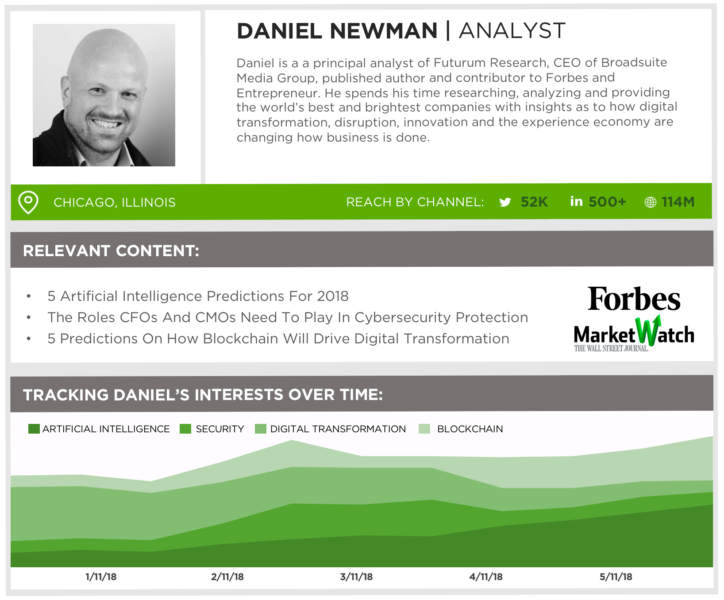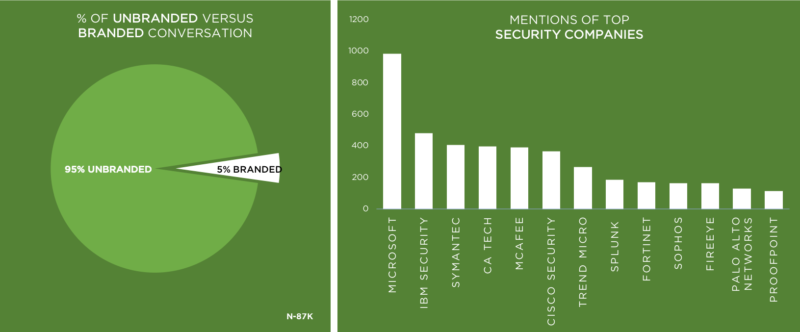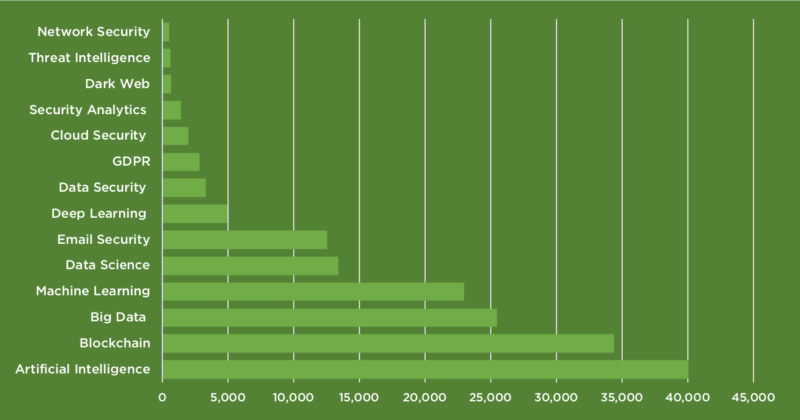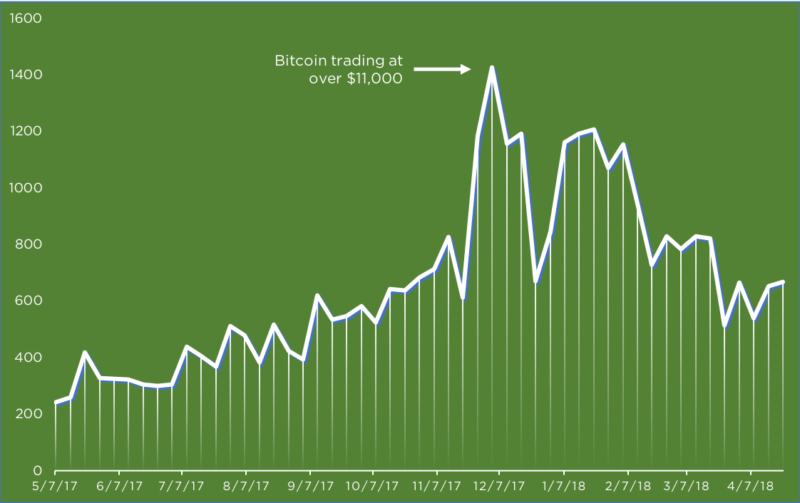How researching B2B influencers can deliver actionable intelligence
Contributor Michael Brito details how to gather and utilize information to inform a successful influencer campaign.
In my last article, I talked about the opportunity that B2B brands have with influencer marketing, leveraging the 1:9:90 Model of Influence.
The next step in this approach is to research and analyze the influencers’ behaviors, media consumption and conversational trends — what are they saying, what are they reading? Doing so will help you forecast and predict what’s top of mind for them today, tomorrow and in the future; and then build a content strategy and engagement plan that will produce results.
What you should be looking for in your research
Rather than analyzing hypotheticals, I wanted to highlight a real example that illustrates the types of data you can extract from researching influencers. We did a quick and accelerated analysis to find influencers on the topic of blockchain and cybersecurity.
Using proprietary methodology and technology, we identified close to 600 influencers who have written and/or talked about cybersecurity within the context of blockchain over the last three months. The influencer audience consists of the following:
- Journalists from the business media: Fortune, Forbes, Wired, Bloomberg, NY Times and the Wall Street Journal.
- Journalists from security tech media: Dark Reading, CIO Online, Hacker News, Bleeping Computer and ZDNet.
- Analysts: Gartner, Forrester, IDG, Constellation Research, Enterprise Strategy Group, HFS Research and Futurum.
- Bloggers, columnists and contributors to several media outlets.
We collected the data, built their profiles and added the influencers to a real-time, searchable listening panel (we use Crimson Hexagon) and tracked their conversations, media consumption and keyword usage over a period of 12 months.
Here’s an example of one influencer, Daniel Newman, an industry speaker, analyst, published author and Forbes contributor:
In looking at Daniel’s conversational patterns since January 2018, you can see that artificial intelligence (noted in the darkest shade of green) and blockchain (the lightest shade of green) are two topics that are becoming increasingly more important to Daniel, based purely on volume of conversation and the content he is publishing and sharing online. Security and Digital Transformation as standalone topics appear to be declining.
This data is critical for many reasons. It will allow you to track what’s “top of mind” for Daniel and inform how and when you might pitch him a story about your product or technology. It’ll also help you understand how to engage with him on social media channels if that’s his preference. And it’ll help you get ahead of any new and emerging trends on the horizon.
Tracking one influencer is insightful, but it’s also critical to look at the data through the lens of a larger influencer audience to get a more holistic view of what topics might be declining in popularity, which new ones are gaining traction and the overall pulse of the marketplace.
For example, over the last 12 months, we wanted to understand what business verticals were top of mind for the 600 influencers, specifically related to security and blockchain. Here’s what we found:
You can see that banking (finance included) is the top vertical being discussed, which certainly makes sense given the topic, followed by technology (startups, software and so on), healthcare and government. Understanding the context of these vertical conversations is important before jumping to any conclusions.
The data doesn’t necessarily mean that the influencers are more interested in one vertical than another. There are other factors to consider: market demand for coverage, government laws, innovation, and even security breaches within each of these verticals may increase the quantity of conversation.
The data only becomes actionable once you drill down to understand the conversational, media and business drivers of each topic.
Examining the branded and unbranded conversation
Outside of the vertical conversation, we also wanted some perspective on the topics that were driving engagement among our group of influencers. In looking at the data, we noticed that some of our influencers were mentioning certain security companies, so we drilled down further.
We started off by isolating all of their security conversations, articles and commentary to ensure we were capturing only the relevant conversations. The clustered data, filtering and human analysis gave us a clear view of what security topics were resonating and trending among our influencer group.
From there, we referenced the BVP Cyber Index list of 29 public companies whose principal business is IT security and have a market cap of $1 billion (USD) to filter out brand mentions. Here’s what we found:
Of the 87,000 security-specific mentions, conversations, articles and overall discussions, 95 percent did not mention any of the security companies we analyzed. This tells us that there is a huge opportunity for one of these companies to capitalize on the lack of engagement.
The branded conversations (5 percent) didn’t really have any surprises, with Microsoft, IBM and Symantec leading the way. This doesn’t mean that our influencers favor one company over another. Many times, it’s simply because they are sharing trending news or writing articles themselves.
For example, just this month there was a large discussion about Microsoft’s acquisition of Github, and Microsoft also garnered a lot of coverage when it announced “Threat Tracker” in their Office 365 Security Service. This was very relevant to our influencer group.
It’s clear that product development, innovation and brand storytelling can drive relevant coverage and drive additional reach, which will naturally result in influencers sharing and discussing the news.
The unbranded conversations give us a clear view as to what’s top of mind for our group of influencers. It’s no surprise that artificial intelligence and blockchain are the number one drivers, considering that our algorithm initially surfaced influencers who talk specifically about and cover both of these topics.
What surprised me was how little Threat Intelligence, Security Analytics and Cloud Security were discussed.
A quick drill-down of the blockchain conversation revealed how important this topic has become over the last 12 months. The spike in December 2017 was due to Bitcoin trading at over $11,000. Bitcoin and blockchain are not the same thing, but they are closely related, and people often inadvertently use “Bitcoin” to mean blockchain and vice versa.
Lastly, we wanted to highlight the “top shared” articles within each of the categories we analyzed. It’s important to note that most of the authors below are a part of our larger influencer group.
This data tells you how these influencers are writing their headlines, where they are contributors and what’s resonating with the larger community.
| Headline | Outlet | Author |
|---|---|---|
| 10 Predictions For AI, Big Data, And Analytics in 2018 | Forbes | Gil Pres |
| Securing IoT with Blockchain | Security Thinking Cap | Eric Vanderburg |
| In the Next Wave Of Innovation, Big Data Is Your Competitive Advantage | Entrepreneur | Artur Kiulian |
| Protecting Critical Infrastructure from Cyber Threats | Dell’s Medium | Eric Vanderburg |
| Open Source Deep Learning Frameworks and Visual Analytics | Data Science Central | Kai Waehner |
| Would Your Employees Open This Fake, Malware-Filled Email? | Huffington Post | Gene Marks |
| Comprehensive Repository of Data Science and ML Resources | Data Science Central | Vincent Granville |
| Top 10 Hot Data Security And Privacy Technologies | Forbes | Gil Pres |
| Important Considerations for Your Business and GDPR | Eric Vanderburg | |
| Top 10 Hot Data Security And Privacy Technologies | Forbes | Gil Pres |
| Building a Cyberresilient Organization | Boston Consulting Group | Walter Bohmayr |
| A security expert built an unofficial Wikipedia for the dark web | Engadget | David Lumb |
| Machine learning-based threat detection is coming to your smartphone | Computer World | Lucas Mearian |
| Here’s What Hackers Don’t Want You to Know | Inc. | John White |
There’s a lot of data here. Now what?
This data only scratches the surface. The reality is that you may never actually engage with any of these influencers outside of pitching stories, and that’s OK. As stated in my last article, influencers drive the conversation and have the ability to impact markets strictly by their words. They influence language, vernacular and the way people talk about certain technologies. And lastly, they can influence search behavior and the actual keywords that users type into Google when looking for more information about a product or service.
If you can get ahead of the curve and begin to understand how influencers are talking, and what jargon and buzzwords they’re using, you can predict and/or begin to adopt the same language in all of your content forms: web pages, blog posts, contributed articles, press releases, social content and ad copy.
The result would be twofold: an increase in brand relevance among the targeted influencers and core audiences and visibility in Google’s organic search results, which we know is the home page for all B2B buyers.
As next steps, consider the following:
- Prioritize your media strategy and build narratives and shareable content about each of the topics that influencers care about through laser-focused pitching, media relations and content marketing.
- Align social and editorial strategy with the trending conversations happening among the influencer audience.
- Tell strategic brand stories across owned media channels and feed the content engine with stories that are top of mind of the influencers.
- Participate in more industry conversations and create shareable content that resonates with the influencers.
In my next article, I will highlight several ways to build an influencer program with a corresponding engagement plan that delivers business outcomes, not just business outputs.
Contributing authors are invited to create content for MarTech and are chosen for their expertise and contribution to the martech community. Our contributors work under the oversight of the editorial staff and contributions are checked for quality and relevance to our readers. The opinions they express are their own.
Related stories





